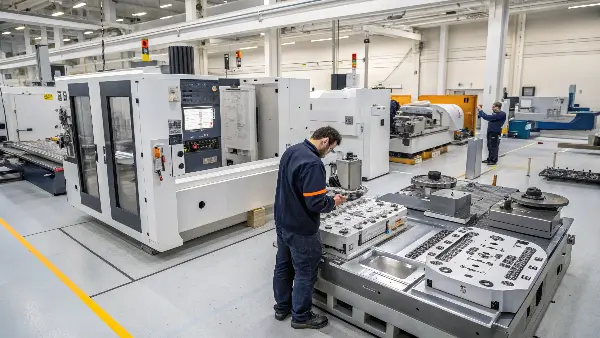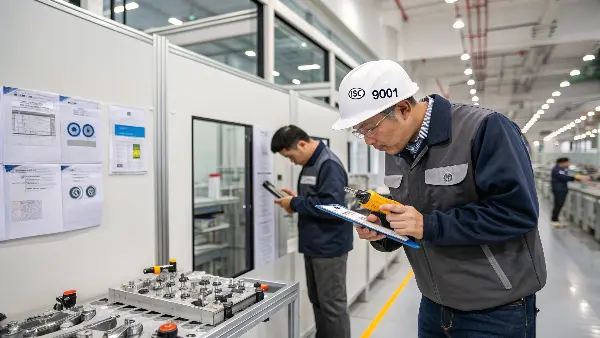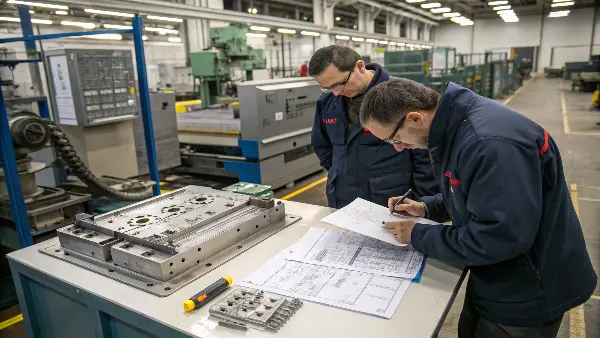Are you tired of injection molding projects going off the rails? Focusing only on the lowest price or the closest supplier often leads to poor quality, missed deadlines, and endless headaches. This narrow view can jeopardize your entire production schedule, leaving you to manage the fallout.
To select the best injection molding supplier, you must look beyond price and location. The most critical criteria include their technical capabilities, a robust quality control system, clear communication and project management processes, and reliable after-sales support. Evaluating these factors ensures a successful long-term partnership, reduces project risk, and ultimately provides a much better return on investment than simply choosing the cheapest or closest option.

It’s easy to compare quotes and shipping distances. Those are just numbers on a spreadsheet. But the real story of a supplier’s value isn’t found there. The success of your project depends on details that don’t show up on a bill. I’ve learned over the years that these "hidden" factors are what separate a simple vendor from a true manufacturing partner. Let’s break down the most important criteria you should be evaluating to ensure your next project runs smoothly and successfully.
How Crucial is a Supplier’s Technical Expertise and Equipment?
Have you ever picked a supplier who claimed they could handle your complex mold design, only to discover their equipment wasn’t up to the task? The result is a mold that fails, forcing costly re-works and pushing your project timeline back by weeks, or even months.
A supplier’s technical expertise and equipment are absolutely critical. This combination determines their ability to produce high-precision, complex molds that meet your exact specifications. You should look for advanced machinery like high-speed 5-axis CNCs and precise EDMs, backed by an engineering team experienced in your specific industry and materials. This is the foundation of a successful molding project, directly impacting part quality and mold longevity.

When you get down to it, making a high-quality mold is about precision. And precision requires both skilled people and capable machines. You can have the best engineers in the world, but if their tools aren’t accurate, the mold won’t be either. I always start my evaluation by looking at a supplier’s equipment list and understanding their team’s experience.
Key Equipment to Assess
The machinery a shop uses tells you a lot about the complexity of work they can handle. A shop with only basic 3-axis CNC machines might be fine for simple parts, but for complex geometries, you need more. A 5-axis CNC machine can cut intricate shapes in a single setup, which increases accuracy and efficiency. Similarly, for fine details and sharp internal corners, you need to see both Wire and Sinker EDM (Electrical Discharge Machining) capabilities on their floor. These technologies are non-negotiable for high-tolerance tooling.
Assessing the Team’s Expertise
Just as important as the hardware is the software—and the people who run it. An experienced engineering team is your greatest asset. One of the first questions I ask is about their use of Mold Flow Analysis. This simulation software predicts how plastic will flow into the mold, highlighting potential issues like warping, sink marks, or air traps before any steel is cut. I remember a project for a medical device part with a particularly tricky design. The supplier we chose presented a Mold Flow report in our first technical meeting. They identified a potential warping issue and suggested a tiny change to a rib thickness. That simple, proactive step saved us a huge headache and a costly mold modification down the road.
| Technology | Why It Matters | What to Ask a Potential Supplier |
|---|---|---|
| 5-Axis CNC Machining | Handles complex geometries, improves precision, and reduces setups. | "Can you show me examples of complex parts made on your 5-axis machines?" |
| Wire & Sinker EDM | Creates fine details, sharp internal corners, and textured finishes. | "What is the smallest corner radius you can achieve with your EDM process?" |
| Mold Flow Analysis | Predicts and solves molding issues like warp, sinks, and fill problems. | "Do you provide a DFM and Mold Flow report for every project?" |
| CMM Inspection | Verifies the dimensional accuracy of the mold core, cavity, and final parts. | "What is your process for final mold and first-article inspection?" |
Investing time to verify a supplier’s technical foundation isn’t just due diligence; it’s risk prevention for your entire project.
What Should You Look for in a Supplier’s Quality Control System?
The fear of receiving a batch of out-of-spec parts is something every project manager has faced. A single quality failure can stall your entire production line, creating a cascade of problems that are difficult to solve. You’re left dealing with angry customers, expensive recalls, and damage to your brand’s reputation, all because a supplier’s quality system wasn’t good enough. Knowing what to look for in a supplier’s quality control process gives you confidence that every part will meet your standards, every time.
You need to look for a robust and well-documented quality control system. This includes certifications like ISO 9001 as a starting point, a dedicated quality assurance team, and clearly defined inspection processes for every stage of manufacturing. Key elements are incoming material inspection, in-process checks, and final part verification using precision tools like a Coordinate Measuring Machine (CMM). A supplier who is serious about quality will be transparent about their system.

Consistent quality doesn’t happen by accident. It is the result of a deliberate, systematic approach. A supplier can talk all day about their commitment to quality, but I need to see the system that backs it up. Certifications are a good starting point, but they are not the whole story.
Certifications are Just the Start
Seeing an ISO 9001 certification on a supplier’s website is a positive sign. It tells you they have a documented quality management system in place. However, it’s a baseline, not a guarantee of excellence. The real question is how they implement that system on a daily basis. I always ask potential partners to walk me through their quality workflow, from the moment they order the steel to the final inspection of the T1 samples.
The Three Pillars of Mold-Making Quality
To really understand their capabilities, I look at three distinct stages of quality control:
- Incoming Quality Control (IQC): Quality starts with the right materials. This process involves verifying the raw materials, specifically the mold steel. Ask them if they provide steel certifications from the mill for every project. A few years ago, we had a mold fail prematurely in production. We eventually traced the issue back to the supplier, who had used a cheaper, uncertified P20 steel to save a few dollars. Now, we insist on seeing the material certs before machining begins.
- In-Process Quality Control (IPQC): This is about catching errors before they become big problems. How do they check dimensions during the machining process? Do they inspect graphite electrodes before they go into the EDM machine? Proactive checks at each step are the mark of a mature quality system.
- Final Quality Control (FQC): This covers the final inspection of the completed mold and the first parts produced from it (T1 samples). This is where a CMM is essential. The supplier should provide a full First Article Inspection (FAI) report that compares the critical dimensions of the sample part directly against your 3D CAD model. This report is your proof that the mold is built to spec.
To be sure, here are some key questions to ask:
- Can you walk me through your quality process, from steel ordering to final shipment?
- What specific quality control equipment do you use (e.g., CMM, optical projectors, hardness testers)?
- May I see a sample of a First Article Inspection (FAI) report you’ve done for a similar part?
- How do you document and address any components found to be out of spec during the process?
A strong quality control system is directly linked to reliability and a lower total cost of ownership. It gives you peace of mind that the mold you receive will perform as expected from day one.
Why is Effective Communication and Project Management Non-Negotiable?
You send an urgent email to your supplier about a critical design detail and get radio silence for days. Your project timeline is slipping, and you have no updates to give your team or your boss. This lack of communication creates immense stress, uncertainty, and distrust. It’s a scenario I’ve lived through, where small misunderstandings balloon into major problems, leading to incorrect parts and project delays. That’s why partnering with a supplier who prioritizes clear communication is non-negotiable for a successful outcome.
Effective communication and project management are the glue that holds a manufacturing project together. Appointing a dedicated project manager, providing regular progress reports with photos, and maintaining a responsive team prevent a constant state of confusion. This transparency builds trust and allows you to proactively manage risks instead of just reacting to problems, ensuring everyone is aligned from kick-off to completion.

A mold maker could have the most advanced machines in the world, but if you can’t get a clear answer from them, the project is destined for trouble. Communication is just as important as technical skill. It is the framework that supports the entire project, ensuring that the final product matches the initial vision.
The Role of the Dedicated Project Manager
The first thing I look for is a single, dedicated point of contact. This person should be a project manager or engineer who speaks fluent English and—more importantly—understands the technical language of mold making. This individual is your advocate inside the supplier’s company. I once worked with a supplier where I had to talk to three different people to get an answer about a single issue. It was a nightmare of repeated explanations and conflicting information. Now, one of my first questions is always, "Who will be my dedicated project manager for this entire project?"
What Good Communication Looks Like
Good communication is more than just answering emails promptly. It’s about being proactive. A great supplier anticipates your questions and provides information before you even have to ask. They establish a clear rhythm of communication so you always know the status of your project.
| Communication Touchpoint | What You Should Expect | Why it’s Important |
|---|---|---|
| Project Kickoff | A detailed review of specifications, timelines, and key milestones. | Ensures everyone is aligned from Day 1 and there are no hidden assumptions. |
| DFM & Mold Flow Review | A formal report and a meeting to discuss their findings and suggestions. | This collaborative step identifies and solves problems before manufacturing begins. |
| Weekly Progress Reports | Clear updates with photos, videos, and percentage of completion for key tasks. | Provides total visibility into the manufacturing process and keeps things on schedule. |
| Mold Trial (T1) | A detailed report, high-quality photos/videos of the trial, and sample parts. | Allows you to assess the mold’s performance and part quality without ambiguity. |
| Shipping Updates | A formal notification with tracking information and clear shipping documents. | Reduces uncertainty and helps you plan for the mold’s arrival and customs clearance. |
Finally, ask about their escalation path. What happens if there’s an issue that your project manager can’t solve? Knowing there is a clear process to speak with a senior manager or owner provides an essential safety net. Strong communication is a direct indicator of a well-organized and professional company you can trust.
What Level of After-Sales Support Should You Expect from Your Mold Maker?
Your brand-new mold has just arrived. It runs well for a few thousand cycles, but then a minor issue pops up. You contact the supplier for help, but they are slow to respond or, worse, completely unresponsive. Now you’re stuck. Your production line is down, you’re losing money every hour, and you have a very expensive tool that isn’t working. This is why understanding a supplier’s after-sales support policy before you place an order is so important. It ensures you have a partner who will stand behind their work long after you’ve paid the final invoice.
You should expect comprehensive after-sales support from any serious mold maker. This must include a full mold documentation package with drawings and maintenance instructions, a set of critical spare parts for wearable components, and a commitment to providing troubleshooting assistance if issues arise. A great partner stands by their craftsmanship and is dedicated to ensuring your mold runs efficiently for its entire expected life.

The job isn’t finished when the mold ships. In many ways, that’s just the beginning of its working life. A supplier’s attitude toward after-sales support is the ultimate test of their commitment to being a partner, not just a vendor.
The Essential Mold Data Package
A professional supplier doesn’t just send you a mold in a crate; they send a complete solution. This includes a full documentation package that is essential for long-term maintenance and troubleshooting. I once received a mold with no documentation at all. When a small ejector pin broke, we had no drawings to reference its exact dimensions or material type. It took our toolroom over a week to reverse-engineer and machine a new one. All our production was stopped during that time. We learned our lesson, and now we always require a full data package.
This package should include:
- Final 2D and 3D mold design files.
- A Bill of Materials (BOM) listing all standard and custom components.
- Steel certifications and heat treatment reports.
- A list of recommended spare parts with sourcing information.
- A clear mold maintenance schedule.
Spare Parts and Ongoing Assistance
Any good mold maker knows which components are most likely to wear out or break over time. They should provide a set of these critical spare parts along with the mold shipment. This typically includes items like ejector pins, sleeves, bushings, and any small, delicate inserts. Having these on hand can turn a multi-day shutdown into a 30-minute fix. Beyond that, the supplier should remain available for troubleshooting. What happens if a flash or cooling issue appears after 100,000 cycles that wasn’t visible during the initial mold trial? A good partner will work with your team remotely to diagnose the problem and recommend a solution.
| Support Feature | A Good Supplier Provides | A Poor Supplier Provides |
|---|---|---|
| Documentation | A complete digital package with all files and reports. | Little to no documentation, forcing you to ask for it. |
| Spare Parts | A set of critical spares included with the mold shipment. | No spares included; slow to respond to requests for parts. |
| Troubleshooting | Responsive and helpful with problem-solving after delivery. | Unresponsive or unhelpful after the final payment is made. |
| Warranty | A clear, written warranty on workmanship and materials. | A vague or non-existent warranty policy. |
After-sales support isn’t a "nice-to-have." It’s a fundamental part of the value proposition and a true measure of a supplier’s confidence in their own work.
Conclusion
In short, choosing the right injection molding supplier goes far beyond comparing prices. By focusing on technical expertise, robust quality systems, proactive communication, and genuine after-sales support, you build a reliable partnership. This comprehensive approach minimizes your risk, ensures consistent quality, and delivers true, long-term value for every project.
